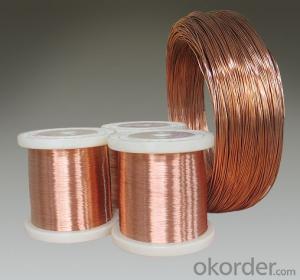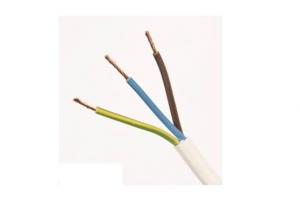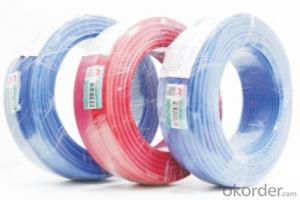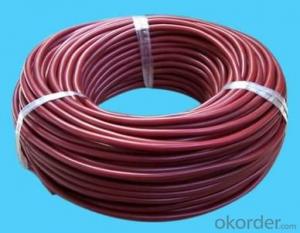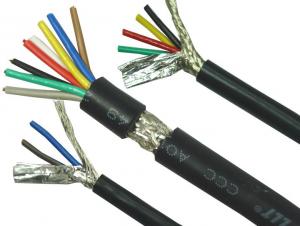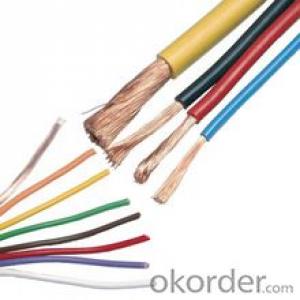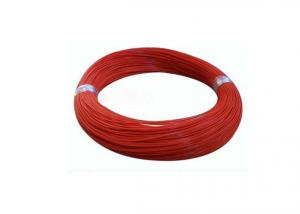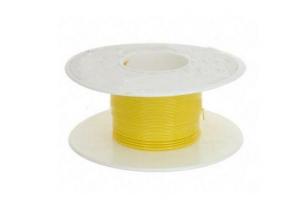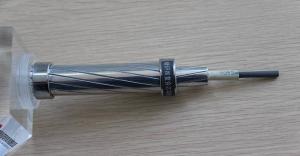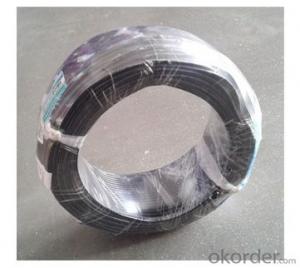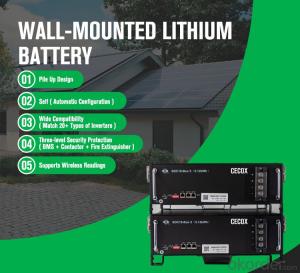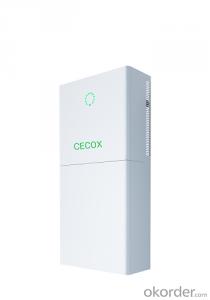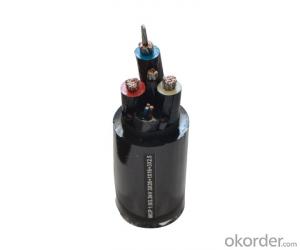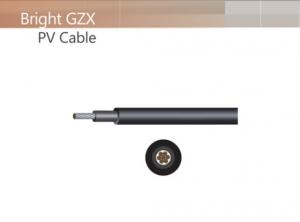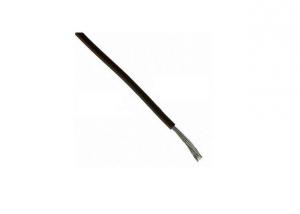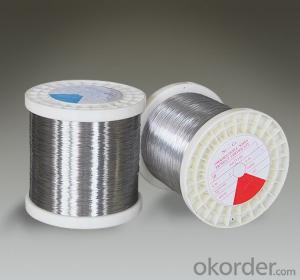Copper-based low resistance heating alloy wire
- Loading Port:
- Shanghai
- Payment Terms:
- TT OR LC
- Min Order Qty:
- 100000 m
- Supply Capability:
- 1000000 m/month
OKorder Service Pledge
OKorder Financial Service
You Might Also Like
Thermocouple Wire
A Thermocouple is a temperature measuring device consisting of two conductors of dissimilar metals or alloys that are connected only at the ends. When the ends are at different temperatures a small voltage is produced in the wire that can be related directly to the temperature difference between the ends. If the temperature at one end is known, the temperature at the other end can be determined.
Application:
Thermocouple wire or extension grade wire is recommended to be used to connect thermocouples to the sensing or control instrumentation. The conditions of measurement determine the type of thermocouple wire and insulation to be used. Temperature range, environment, insulation requirements, response, and service life should be considered.
What do we have?
Thermocouple wire ( extension/compensation/compensating):
Type: K, T, N, E, J, L, B, R, S
Insulation or jacket: PVC, Telflon, PFA; Silicon rubber, Fiberglass, Quartz Fibre.
Sheild: Tin-coated copper braid/Stainless steel braid sheild.
Calibration Type Characteristics
Type J (Iron vs Constantan) is used in vacuum, oxidizing, inert or reducing atmospheres. Iron element oxidizes rapidly at temperatures exceeding 1000ºF (538ºC), and therefore heavier gauge wire is recommended for longer life at these temperatures.
Type K (CHROMELvs ALUMEL) is used in oxidizing, inert or dry reducing atmospheres. Exposure to vacuum limited to short time periods. Must be protected from sulfurous and marginally oxidizing atmospheres. Reliable and accurate at high temperatures.
Type T (Copper vs Constantan) is used for service in oxidizing, inert or reducing atmospheres or in vacuum. It is highly resistant to corrosion from atmospheric moisture and condensation and exhibits high stability at low temperatures; it is the only type with limits of error guaranteed for cryogenic temperatures.
Type E (CHROMELvs Constantan) may be used in oxidizing, inert or dry reducing atmospheres, or for short periods of time under vacuum. Must be protected from sulfurous and marginally oxidizing atmospheres. Produces the highest EMF per degree of any standardized thermocouple.
Type N (Nicrosilvs Nisil) is used in oxidizing, inert or dry reducing atmospheres. Must be protected from sulfurous atmospheres. Very reliable and accurate at high temperatures.
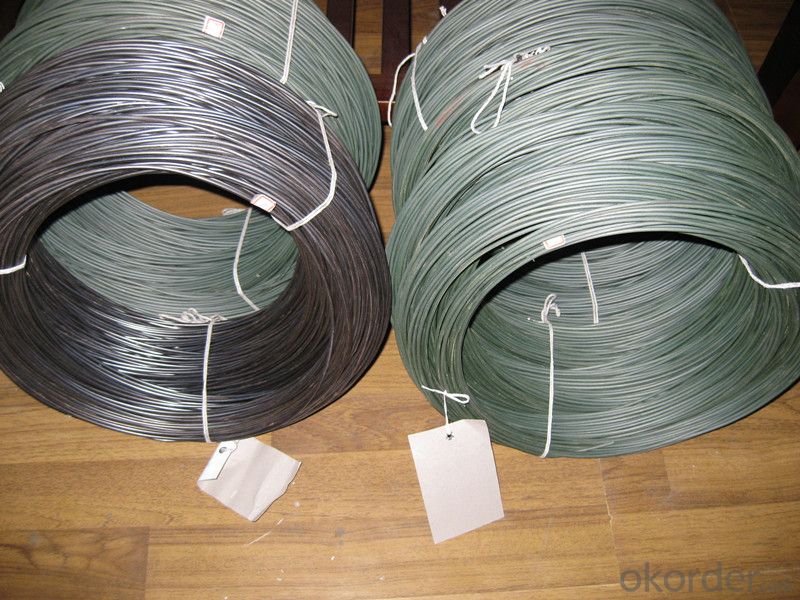
Do you provide free samples?
Yes, we can provide a free sample for testing, If we have sample in stock, The quantity based on the material type, The buyer should bear all the shipping costs.
Please feel free to send us a inquiry and we are looking forward to cooperating with you!
Before you send us a inquiry, please confirm the following information
1. Alloy grade
2. Dimensions of the alloys
3. Surface requirements
4. Size tolerance requirement
5. Quantities
6. Package request
7. Specific end use
8. Other information that may be useful in supplying the most suitable products
| Color code & initial calibration tolerances for thermocouple wire: | ||||||
| Thermocouple Type | ANSI Color Code | Initial Calibration Tolerances | ||||
| Wire Alloys | Calibration | +/- | Overall | Temperature Range | Standard | Special |
| Conductor | Limits | Limits | ||||
| CHROMEL(+) vs. | K | Yellow/Red | Brown | -200° C to -110° C | ± 2% | ± 1.1° C |
| ALUMEL(-) | -110° C to 0° C | ± 2.2° C | ± . 4% | |||
| 0° C to +285° C | ± 2.2° C | |||||
| FB-FB-SSB Physical Properties | ||||||
| Characteristics | ||||||
| Specific Gravity | Insulation | Overall | ||||
| Tensile Strength; psi (min) | 2.54 | 2.54 | ||||
| Elongation; %(min) | 250, 000 at 1000& deg; F(537° C ) | 250, 000 at 1000& deg; F(537° C ) | ||||
| Minimum Bend Radius | 4.8 | 4.8 | ||||
| Abrasion Resistance | 5x O. D. | 10x O. D. | ||||
| Cut Through Resistance | Good | Good | ||||
| Moisture Resistance | Very Good | Excellent | ||||
| Solder Iron Resistance | Good | Good | ||||
| Service Temperature | Excellent | Excellent | ||||
| Flame Test | 260° C continuous 343° C single exposure | 260° C continuous 537° C | ||||
| single exposure | ||||||
| Non-flammable | Non-flammable | |||||
| Thermocouple variety and index | Measurement range C | |
| Variety | Index | |
| PtRh30-PtRh6 | B | 600~1700 |
| PtRh13-Pt | R | 0~1600 |
| PtRh10-Pt | S | 0~1600 |
| NiCr-NiSi | K | -200~1300 |
| NiCr-CuNi (constantan) | E | -200~900 |
| Fe-CuNi (constantan) | J | -40~750 |
| Cu-CuNi (constantan) | T | -200~350 |
| NiCrSi-NiSi | N | -200~1300 |
| NiCr-AuFe0.07 | NiCr-AuFe0.07 | -270~0 |
- Q:All the other outlets in the room have one black and one white wire. The outlet with 2 is not connected to a switch or anything. Could the extra set of wires be and end run from a different connection? Can I take the extra black and extra white from the bottom tabs of the outlet and extend it behind the kneewall into the hallway and make a new outlet? I have none in the hallway and I've always wanted one there. Thanks.
- Sometimes an outlet is used as a 'splice' connector. One pair might be 'in', the other 'out' to the next outlet. It's not especially good practice, but it's safe if the connections are good, and often done
- Q:Wire on the 3 +2 with 4 +1 What is the meaning, please speak of the popular point, too professional do not understand.
- The number 3 + 2 and 4 + . refers to the wire inside the skin, including five more thin wire; wire "3 +2", refers to the wire inside the five insulated wire, The three wires cross-sectional area of the same), the other two of the wires connected to a zero line (ie, the neutral line, the cross-sectional area than the previous three small), the remaining one ground wire (cross-sectional area than the first three small) ; Wire "4 +1", refers to the wire within the skin by the four insulated wires, if by the lighting of the "voltage 220v" two-phase line, one of the wires connected to the line, the other one wire Then the neutral line (ie, the neutral line), and then a wire grounding wire (ie grounding protection line), leaving the remaining two wires on the empty.
- Q:I want to install 110W bulbs instead of 55W bulbs on my 2003 subaru legacy so i can see better at night. the stock bulbs are not bright enough. will i melt the wiring with the extra current?
- Hotter headlights might damage the housing due to the heat as you're doubling the output. The current and wiring should not be an issue, however. Anything brighter than OEM is illegal and might earn you a ticket from local law enforcement . Parts on a car are designed to work safely. So the reason you have 55W bulbs are so as not to blind other drivers. This is something few people consider when buying auto accessories. Make sure that the headlights are aimed properly, so the proper amount of light is on the road. Brighter headlights will not solve this problem. Driving lights might be a better alternative, but make sure that they are low beams and aimed to the road and not the trees. Hella makes a good set.
- Q:I accidentally cut a hidden outside electrical outlet with my lawn mower. The outlet was knocked off the wires and they are now exposed. I've managed to isolate the breaker and shut it off, which is a temporary fix. The outlet is pretty useless (it was kind of hidden by a well that I was cutting around, and forgotten) and not used anymore. So, I'm not really interested in replacing it - I want to know how to cover the wire so it isn't an exposed live electrical wire in my yard. How easy is this?
- UK answer. If the outlet is no longer required disconnection of the wiring for it from the breaker would be the safest and probably the best method.
- Q:Does anyone know of any places that offer emergency electrical wiring assistance in Florida for the low income? I own my home and live in Lakeland but this home was built in 1970, my electrical socket in the living room shoots sparks the circuit panel is old and a bit rusty and shot sparks last night my lights go out just about every other day for short periods of time I dont know what to do and cant seem to find help if anyone knows anything PLEASE let me know, im so scared im going to come home to a burned down house im so poor i cant even afford homeowners insurance so im in a bind!
- While Mister Sparky may not be the cheapest they certainly provide excellent service and you don't want to cheap out on your electrical system, especially if it's sparking. They may offer financing. Try 888-877-2759
- Q:can i just connect a regular electrical wire on there ?
- My husband has put new heads on cords in the past. Find someone who is handy and they will be able replace it for you.
- Q:As we know the earth wire takes no current or just a small amount of leakages current, why we should use same size as live or neutral wire in a power system??
- Rule of thumb is that the earth wire should be half the csa of the phase conductor. This ensures that it can carry the maximum fault current that could occur at that point for sufficient time for the protective device to operate.
- Q:I notice that theyre usually associated with two poles
- Ok from the terminology you use I think you are american I am from the uk so i may use different terms Your hot wire/Live wire is the input to the Appliance and the neutral is the outgoing feed so hot in from the power Company and neutral is the return back to the electric company
- Q:Hey guys,After diagnosing my car I found that my push to start was acting up. I went inside and found that the power wire had poor conductivity. Denying the car it's power. I released the wire and saw that it was completely black flaking off. That was the only issue though, everything else was in perfect condition. What kind of wire should I replace this with, is there wires that can support more of a charge? Or was it just wear and tear?As for now I just cut the wire in half and re stripped it, using the good part of the wire. Temporary fix until I purchase a better wire.Thanks
- all electrical wires are power wires. For an authoritative answer, we'd need to know which one you mean, and which make model it's on. However, to generalize, I'd be wondering why the wire was in that condition, fixing whatever it was, then replacing the wire with one with a slightly greater cross-sectional area (gauge).
- Q:I would like to know what the standards are for Big Fat power leads being exposed, isn't that an OSHA hazard? What are all the volts, that need to be covered by a floor wire covers, so nobody will trip in them. Anyone know about this any helpful information regarding wiring safty on the job? Can a place be shut down for employee safty reasons? What are the major voltages in America? Honest and non- rude opinions Please Thank You
- In areas where untrained personnel will be, no leads should ever be exposed. The typical covering to a machine, especially a permanently mounted machine running at 480 VAC, is flexible conduit to a disconnect and then EMT or rigid conduit. However, cord connected equipment is not uncommon, even at 480 volts, especially if it is mobile, like portable pump stations. The difference between a cord and exposed leads is a cord has all of the leads tightly held together with a thick outer sheath of rubber protectiing them from damage/contact. Exposed leads are the individual wires that are run in conduit or are found inside of a cord. The leads will have their own outer covering, typically harder than the rubber you find on the cord because it is a different material, rated to contain the voltage running on the actual wire (most often copper or aluminum). Standard voltages: 120/208 120/240 277/480 Anything above these is not a standard that most people will be exposed to. It would not be typical to immediately shut anyone down. Normally a citation or warning is issued with a time frame for correction and reinspection. Both your local fire department and OSHA are very concerned with exposed live wires and either of these will normally respond to a complaint and NOT divulge who called, if you so stipulate when and if you call., though not for what many people call low voltage, the voltages many doorbells, intercoms, phones, audio/video, etc., may run at (perhaps in the 12 to 50 volt range).
1. Manufacturer Overview |
|
|---|---|
| Location | |
| Year Established | |
| Annual Output Value | |
| Main Markets | |
| Company Certifications | |
2. Manufacturer Certificates |
|
|---|---|
| a) Certification Name | |
| Range | |
| Reference | |
| Validity Period | |
3. Manufacturer Capability |
|
|---|---|
| a)Trade Capacity | |
| Nearest Port | |
| Export Percentage | |
| No.of Employees in Trade Department | |
| Language Spoken: | |
| b)Factory Information | |
| Factory Size: | |
| No. of Production Lines | |
| Contract Manufacturing | |
| Product Price Range | |
Send your message to us
Copper-based low resistance heating alloy wire
- Loading Port:
- Shanghai
- Payment Terms:
- TT OR LC
- Min Order Qty:
- 100000 m
- Supply Capability:
- 1000000 m/month
OKorder Service Pledge
OKorder Financial Service
Similar products
New products
Hot products
Hot Searches
Related keywords
